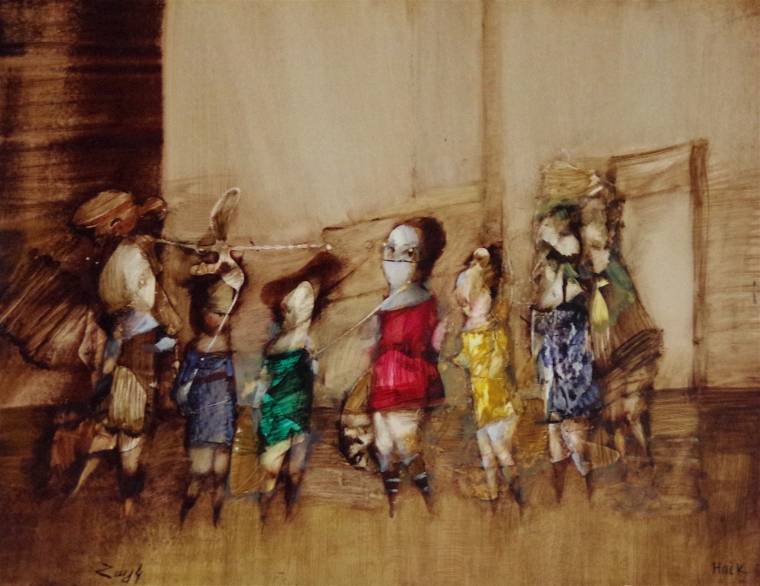Figurative Oil Painting: From Concept to Canvas - A Step-by-Step Technique
Figurative Oil Painting: From Concept to Canvas - A Step-by-Step Technique
Blog Article
The Duty of Emotion and Expression in Metaphorical Oil Painting: A Comprehensive Evaluation of Subject and Make-up
The interplay of feeling and expression in figurative oil painting functions as an essential lens whereby one can take a look at the complex partnership in between subject matter and make-up. Artists harness different techniques, from shade selection to brushstroke dynamics, to grow emotional vibration within their jobs. This nuanced orchestration not just shapes audience understanding but also welcomes a deeper query right into how these elements integrate to reflect the complexities of human experience. As we explore this abundant terrain, one should consider how certain instance studies illuminate the wider implications of these artistic choices.
Comprehending Emotion in Art
Emotion in art works as a powerful avenue for expression, allowing musicians to convey intricate sensations via their job. In metaphorical oil painting, this psychological depth is frequently represented through the depiction of the human number, capturing the subtleties of human experience. The option of topic, color palette, and brushwork all add to the emotional resonance of an item.
Artists frequently bring into play personal experiences, societal concerns, or universal motifs to evoke feelings in the customer. A picture may mirror vulnerability, while a vibrant figure in motion can signify liberty or turmoil. These emotional threads attach the visitor to the art work, promoting a dialogue that goes beyond the visual tool.
Moreover, the interaction in between light and darkness can amplify psychological intensity, assisting the visitor's gaze and attracting focus to specific elements within the structure. The usage of appearance in oil paint additionally adds layers of complexity, inviting a responsive reaction that improves the emotional experience. On the whole, comprehending feeling in art is essential for appreciating the nuances that define metaphorical oil paint, as it transforms simple representation right into a profound exploration of the human problem.
Crucial Element of Composition
In the realm of figurative oil paint, the composition works as the underlying structure that organizes visual components and improves the psychological narrative. Essential elements of structure include equilibrium, comparison, centerpiece, and rhythm, each contributing to the total influence of the art work.
Balance describes the distribution of aesthetic weight within the painting, which can be accomplished with asymmetrical or balanced plans. A well-balanced make-up gives stability, enabling the audience to involve with the item sympathetically - figurative oil painting. Contrast, on the various other hand, involves comparing various aspects, such as light and dark or cozy and great shades, to guide the customer's eye and evoke emotional feedbacks
The focal point is important, as it guides interest to the most significant component of the painting, usually highlighting the psychological core of the narrative. By masterfully incorporating these vital components, artists can craft engaging and emotionally resonant metaphorical oil paintings that astound and involve their target market.
Subject and Its Effect
Subject plays a crucial function in metaphorical oil paint, as it not just functions as the foundation for the story yet also forms the viewer's analysis and emotional involvement with the art work. The choice of subject matter-- be it a singular figure, a group dynamic, or a thematic depiction-- straight influences the emotional ambience conveyed to the target market.

As an example, portraits usually evoke individual connections, revealing the intricacies of human expression and character, while scenes depicting public tasks can produce a feeling of belonging or nostalgia. The cultural and historical context of the subject matter enriches the customer's understanding, triggering much deeper reflections on societal standards, values, and the human problem.
Different subject issues also produce differing levels of involvement; a dramatic dispute shown via figures in tension may generate sensations of anxiety or empathy, while peaceful landscapes can invoke tranquility and contemplation. Inevitably, the impact of subject in metaphorical oil painting is extensive, as it offers as a conduit for emotional resonance, leading the viewer's feedback and analysis, and promoting a connection in between the onlooker and the art work. This interaction is necessary for the effective communication of the artist's intent.
Methods for Evoking Sensations
The efficiency of metaphorical oil painting in sharing emotions is significantly affected by the methods employed by the musician. Among the most essential techniques is making use of shade concept, where the strategic choice of colors can evoke particular emotional responses. Warm shades, such as reds and oranges, often generate feelings of interest or hostility, while cooler tones like blues and greens have a tendency to evoke calmness or despair.
One more essential technique is the manipulation of light and darkness, known as chiaroscuro. This approach improves the three-dimensionality of figures, producing dramatic contrasts that can intensify emotional deepness. The click this positioning of light can lead visitors' feelings, highlighting particular components of the composition.
Brushwork also plays a vital role; loose, expressive strokes can convey power and figurative oil painting spontaneity, whereas smoother strategies may recommend harmony or precision. The setup of topics within the make-up can affect psychological effect. Close proximity can suggest affection, while distance may indicate seclusion.
Eventually, the mix of these methods allows artists to craft stories that resonate with the audience, transforming a plain visual experience right into an expressive emotional trip. - figurative oil painting

Study of Notable Functions
Checking out remarkable jobs of figurative oil painting discloses how various techniques are utilized to evoke effective feelings. One excellent case is Edvard Munch's "The Scream," where the distorted number and swirling history communicate existential fear. Munch's use of color-- deep blues and vivid oranges-- escalates the psychological influence, showcasing exactly how combination options can form visitor experience.
Another substantial work is Pablo Picasso's "Les Demoiselles d'Avignon." Here, vibrant brushstrokes and fragmented forms show a tumultuous emotional landscape, testing conventional depictions of the women number. Picasso's cutting-edge structure not only records the visitor's attention but likewise invites reflection on motifs of identification and sexuality.
Furthermore, Frida Kahlo's "The 2 Fridas" provides an emotional exploration of duality and self-identity. The different figures, linked by a common heart, exhibit Kahlo's psychological depth and personal story. figurative oil painting. Her precise interest to information and symbolic elements serve to engage customers on a natural level
These instance studies highlight the profound connection in between feeling and composition in metaphorical oil paint, revealing just how musicians harness strategy to interact complex feelings and stories that reverberate throughout time and culture.

Conclusion
In final thought, the interplay of feeling and expression in figurative oil paint substantially improves the visitor's experience and analysis of the art work. With a cautious choice of subject matter and compositional techniques, artists convey profound stories that resonate on both global and individual degrees. The application of shade brushwork, chiaroscuro, and concept additional magnifies emotional deepness, changing each canvas right into a powerful reflection of the intricacies of the human experience.
In metaphorical oil click over here paint, this emotional deepness is often portrayed through the depiction of the human number, catching the nuances of human experience.Moreover, the interaction in between light and darkness can enhance emotional intensity, guiding the customer's look and drawing focus to specific aspects within the structure. The use of appearance in oil painting further adds layers of complexity, welcoming a responsive response that boosts the psychological experience.The focal factor is vital, as it directs focus to the most substantial part of the painting, commonly highlighting the emotional core of the story. Inevitably, the influence of subject issue in figurative oil painting is extensive, as it offers as a channel for psychological vibration, leading the customer's feedback and interpretation, and cultivating a connection between the artwork and the observer.
Report this page